Current Issue : Article / Volume 3, Issue 1
- Research Article | DOI:
- https://doi.org/10.58489/2836-5933/008
Evaluating the use of ICT Tools in Precision Agriculture for Efficient Pesticide Management
- Department of Computer Science Federal School of Statistics, Manchok, Kaduna State.
- Department of Statistics Federal School of Statistics, Manchok, Kaduna State.
- Department of General Studies Federal School of Statistics, Manchok, Kaduna State.
Asere Gbenga Femi
Asere Gbenga Femi. James Sambo Wujat, Joseph Williams Enam, (2024), Evaluating the use of ICT Tools in Precision Agriculture for Efficient Pesticide Management. Journal of Marine Science and Research. 3(1). DOI: 10.58489/2836-5933/008
© 2024 Asere Gbenga Femi, this is an open-access article distributed under the Creative Commons Attribution License, which permits unrestricted use, distribution, and reproduction in any medium, provided the original work is properly cited
- Received Date: 20-02-2024
- Accepted Date: 02-02-2024
- Published Date: 05-02-2024
ICT Tools, Precision, Agriculture, Pesticide.
Abstract
The research study aims to investigate and evaluate the use of ICT (Information and Communication Technology) tools in precision agriculture for efficient pesticide management. Precision agriculture, as a modern approach to farming, leverages technology to optimize crop production practices. However, the potential benefits of ICT tools, specifically in pesticide management, require further investigation and assessment. The findings of this research endeavor will provide valuable insights into the role of ICT tools in precision agriculture for pesticide management. The evaluation will shed light on the benefits and challenges associated with deploying these tools, including their impact on reducing pesticide use, optimizing resource allocation, and promoting environmental sustainability. Moreover, the research will contribute to the identification of best practices and key considerations for the successful integration of ICT tools in the realm of precision agriculture.
Overall, this research will enhance our understanding of how ICT tools can revolutionize pesticide management and pave the way for more efficient and sustainable agricultural practices. The findings will serve as a crucial reference for farmers, policymakers, and researchers seeking to optimize pesticide usage, minimize environmental risks, and improve overall crop yield in the context of precision agriculture.
Introduction
Precision Agriculture (PA) is a cultivating the board methodology in view of noticing, estimating and answering worldly and spatial changeability to further develop rural creation sustainability [3]. It is utilized in both harvest and animals creation. Precision Agriculture frequently utilizes innovations to robotize rural tasks, working on their conclusion, direction or performance [2]. The objective of accurate horticulture research is to characterize a choice emotionally supportive network for the entire ranch the board fully intent on streamlining returns on inputs while protecting resources [1].
Among these many methodologies is a phytogeomorphological approach which ties long-term crop development solidness/qualities to topological territory credits [1]. The interest in the phytogeomorphological approach originates from the way that the geomorphology part commonly directs the hydrology of the homestead field [1].
The act of accuracy agribusiness has been empowered by the appearance of GPS and GNSS. The rancher's as well as specialist's capacity to find their exact situation in a field considers the production of guides of the spatial fluctuation of however many factors as can be estimated (for example crop yield, landscape highlights/geography, natural matter substance, dampness levels, nitrogen levels, pH, EC, Mg, K, and others) [5]. Comparable information is gathered by sensor exhibits mounted on GPS-prepared join reapers. These clusters comprise of constant sensors that action everything from chlorophyll levels to establish water status, alongside multispectral imagery. This information is utilized related to satellite symbolism by factor rate innovation (VRT) including seeders, sprayers, and so forth to circulate assets ideally. Nonetheless, late mechanical advances have empowered the utilization of ongoing sensors straightforwardly in soil, which can remotely send information without the need of human presence [5, 6].
Problem Statement
The use of Information and Communication Technology (ICT) tools in precision agriculture has gained significant attention due to its potential in improving pesticide management. However, there is a need to evaluate the effectiveness and efficiency of these ICT tools in achieving the goal of efficient pesticide management in precision agriculture. The current research aims to address this gap by investigating the impact and usability of ICT tools in precision agriculture for pesticide management, in order to provide valuable insights and recommendations for the adoption and improvement of these tools in real-world farming practices.
Aim and objectives of the study Aim
The aim of this research is to assess the use of ICT (Information and Communication Technology) tools in precision agriculture, specifically focusing on their effectiveness in improving pesticide management. By conducting a comprehensive evaluation, the aim is to determine the impact of ICT tools on the overall efficiency, sustainability, and effectiveness of pesticide application in precision agriculture systems.
Objectives
- To review the existing literature on precision agriculture and the use of ICT tools in pesticide management.
- To identify and evaluate different ICT tools utilized in precision agriculture for pesticide management, including remote sensing, GPS (Global Positioning System), drones, sensors, and data analytics.
- To propose recommendations for the integration and optimization of ICT tools in precision agriculture systems to improve pesticide management.
- To explore the potential future developments and advancements in ICT tools that can further enhance pesticide management in precision agriculture.
- To contribute to the scientific knowledge and understanding of how ICT tools can be effectively utilized to promote sustainable and efficient pesticide management in precision agriculture.
Importance of the Study
The use of ICT tools in precision agriculture for efficient pesticide management holds great significance for several key stakeholders in the agricultural industry. For farmers and agricultural practitioners, this research will provide valuable insights into the effectiveness and efficiency of ICT tools in managing pesticides. By understanding the impact of these tools, farmers can make informed decisions regarding their adoption and integration into their farming practices. This can potentially lead to improved pest control, reduction in pesticide usage and associated costs, and ultimately, increased crop yield and profitability. Also, the study will benefits researchers and scientists involved in the development and enhancement of ICT tools for precision agriculture. By evaluating the usability and performance of these tools, researchers can identify areas for improvement and design more effective solutions that cater to the specific needs and challenges of pesticide management in farming.
- Summary of Related Works
The headway and execution of accuracy horticulture or site-unequivocal development has been made possible by joining the GPS and Geographic Data Framework (GDF). These developments enable the coupling of progressing data grouping with exact position information, inciting the successful control and examination of a gigantic measure of geospatial data. GPS-based applications in accuracy farming are being used for horticulture arranging, field arranging, soil assessment, crop investigation, variable rate applications, and yield planning. GPS licenses laborers to work during low-perceivability field conditions, for instance, storm, buildup, cloudiness, and indefinite quality.
II. Materials And Methods
1. Literature Review
This study Begin by conducting an extensive review of existing academic literature, scientific articles, and reports related to ICT tools in precision agriculture and pesticide management. This helps the researchers to establish a solid foundation by understanding previous studies, methods used, and any knowledge gaps that need to be addressed.
2. Field Observations
The researchers conducted field visits to agricultural sites where precision agriculture practices are being implemented. Observe the utilization of ICT tools for pesticide management, document their usage patterns, and record any observable improvements or challenges. These first-hand observations will provide valuable insights into the practical application of ICT tools and their impact on pesticide management efficiency.
3. Case Studies
The researchers select specific farms or agricultural regions that have successfully deployed ICT tools for precision agriculture and pesticide management. Conduct in-depth case studies by interviewing farmers, farm managers, and technicians to gather detailed information about the implemented practices, challenges encountered, and the overall outcomes achieved.
4. Comparative Analysis:
the researchers compare the outcomes and findings from different farms or agricultural regions utilizing varying ICT tools for precision agriculture and pesticide management. This comparative analysis will help identify best practices, effective ICT tool implementations, and potential areas for improvement. It can also provide insights into the economic, environmental, and social benefits associated with the use of ICT tools in precision agriculture.
Results And Discussion
For better understanding of the study at hand the following concepts need to be discussed briefly;
- Agriculture
- Pesticide and
- Precision Agriculture
- Pesticide Management in Agriculture
1 Agriculture:
Agriculture is the practice of cultivating plants and rearing animals for food, fiber, medicinal plants, and other products used by humans. It is a fundamental activity that has been crucial for the survival and progress of civilizations throughout history. In modern times, agriculture has evolved significantly through technological advancements and scientific innovations. Various methods and approaches are used to maximize crop yield, improve livestock production, and enhance overall agricultural efficiency. Crop cultivation involves selecting appropriate crops, preparing the soil, planting seeds, managing water and nutrients, controlling pests and diseases, and harvesting the mature crops. This process can be influenced by factors such as climate, soil conditions, and availability of resources. Livestock rearing, on the other hand, involves the breeding, feeding, and management of domesticated animals for the production of meat, milk, eggs, and other animal-derived products. Animal welfare, nutrition, disease prevention, and sustainable farming practices play vital roles in successful livestock management. Advances in agricultural technology have revolutionized the industry.
2. Pesticides:
Pesticides are chemical substances that are used to control or kill pests, including insects, weeds, fungi, and microorganisms that can negatively impact crops, livestock, or human health. They are commonly utilized in agriculture to protect crops from pests and increase agricultural yields. Pesticides can be categorized into various types, such as insecticides, herbicides, fungicides, rodenticides, and bactericides, depending on the target pest they are designed to combat. While pesticides can be effective in managing pests, their use needs to be carefully regulated and monitored to minimize potential risks to the environment and human health.
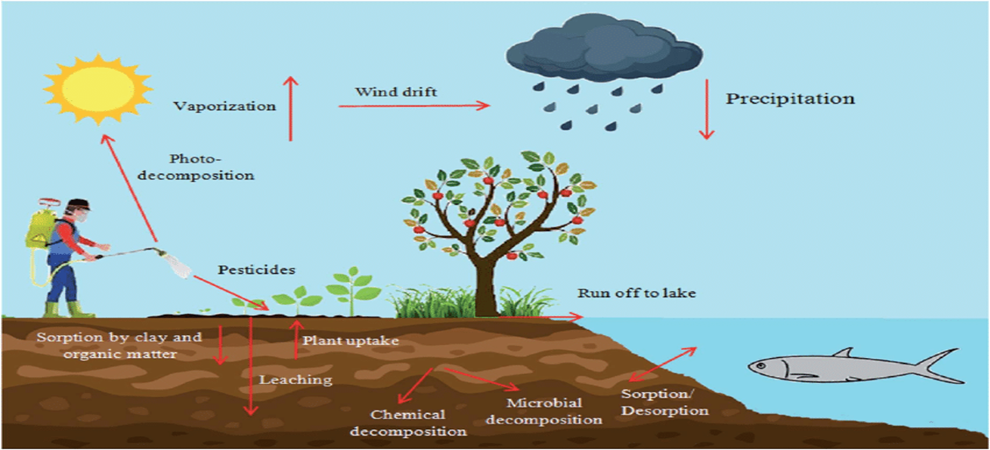
Precision agriculture: Precision agriculture, also known as precision farming, is an advanced approach to agricultural management that utilizes technology and data to improve the efficiency and accuracy of various farming practices. Precision agriculture aims to optimize the use of resources such as water, fertilizers, and pesticides, while also minimizing the environmental impact and maximizing crop productivity. Precision agriculture involves the integration of various technologies, including global positioning systems (GPS), geographic information systems (GIS), remote sensing, and advanced data analytics. These technologies enable farmers to gather and analyze precise spatial and temporal data about their fields, allowing them to make informed decisions tailored to specific areas of land. One important aspect of precision agriculture is the concept of precision planting, which refers to optimizing the spacing and depth of seeds during planting to ensure uniformity and maximize crop production. By using GPS technology and computer-controlled equipment, farmers can precisely plant seeds at specific locations within a field, accounting for variations in soil conditions, topography, and other factors. This helps to ensure that each plant has the best opportunity for growth and reduces resource wastage. Precision agriculture also involves the use of remote sensing techniques, such as aerial drones or satellites, to capture high-resolution imagery of crop fields. This imagery can help detect variations in plant health, nutrient deficiencies, or pest infestations, which can then be addressed in a targeted and efficient manner. By detecting and addressing these issues early, farmers can take proactive measures to minimize crop losses and optimize yields. Overall, precision agriculture allows farmers to make data-driven decisions and implement site-specific management strategies
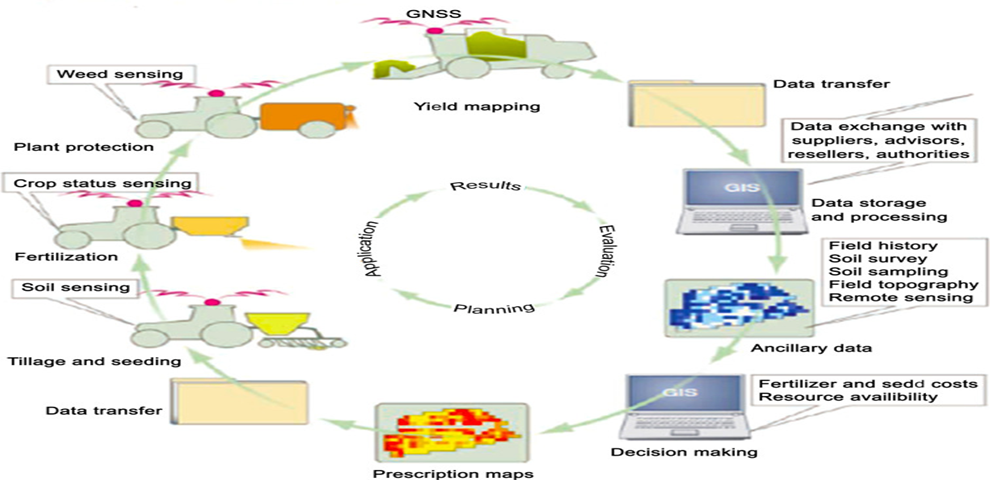
4. Pesticide Management in Agriculture: Pesticide management in agriculture refers to the practices and strategies employed to effectively and responsibly use pesticides to control pests and diseases while minimizing their negative impacts on human health, the environment, and non-target organisms. It involves a systematic approach that encompasses various stages, including pesticide selection, application, storage, disposal, and monitoring
1. Pesticide Selection: Choosing the right pesticide involves considering factors such as the target pest, crop type, application method, and potential environmental impacts. Integrated Pest Management (IPM) principles are often employed to prioritize non-chemical controls, such as cultural practices and biological control methods, before resorting to pesticides.
2. Application Techniques: Proper application techniques are crucial to ensure effective pest control while minimizing pesticide drift and reducing off-target effects. Appropriate equipment, such as sprayers or precision application devices, should be used to accurately deliver the pesticide to the target area.
3. Timing and Dosage: Appropriate timing of pesticide application is essential to target pests during their vulnerable stages and minimize the need for repeated applications. Additionally, using the correct dosage as specified by the pesticide manufacturer is crucial to optimize efficacy while minimizing the risk of resistance development and environmental contamination.
4. Storage and Handling: Pesticides should be stored securely in designated areas that meet safety requirements to prevent accidental spills or unauthorized access. Proper handling procedures, including wearing protective equipment and following label instructions, are essential to ensure the safety of handlers and minimize pesticide exposure.
5. Disposal and Waste Management: Unused or expired pesticides must be properly disposed of to prevent contamination of soil, water, or air. Recycling programs or authorized waste disposal facilities should be used for safe and responsible pesticide waste management.
6. Monitoring and Record-Keeping:
Regular monitoring of pest populations, crop health, and pesticide efficacy helps to evaluate the success of pesticide management practices. Keeping detailed records of pesticide applications, including dates, dosages, and weather conditions, facilitates tracking and analysis of pesticide use patterns and potential impacts.
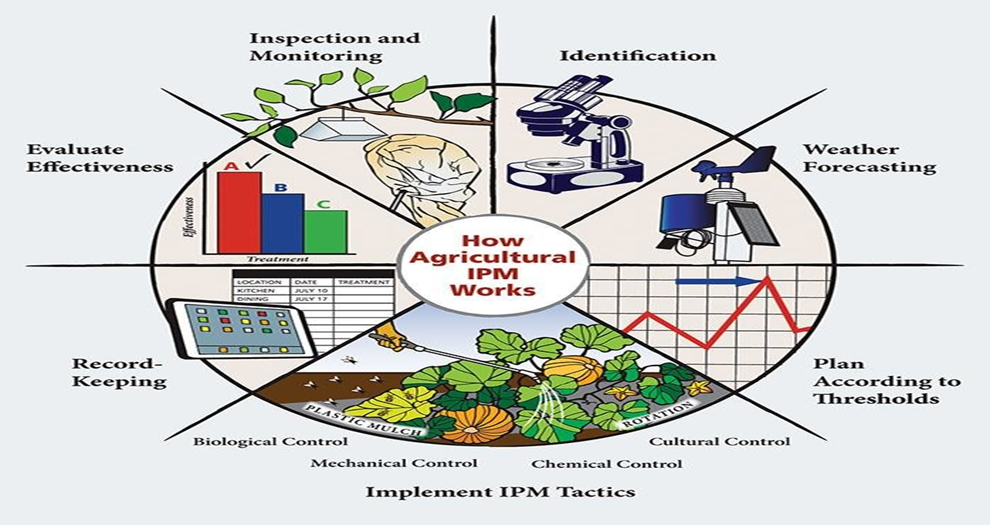
ICT Tools That Can Be Use in Precision Agriculture for Efficient Pesticides Management
In the course of this research the researchers found out that the following ICT tools are useful in precision Agriculture and efficient pesticides management:
1. Sensor Technology: Implementing sensor technology can help monitor various environmental factors such as humidity, soil moisture, temperature, and light intensity. By collecting real-time data, farmers can gain valuable insights into the optimal conditions required for pesticide application.
2. Drones: Unmanned aerial vehicles (drones) equipped with cameras and sensors can be used to assess crop health, detect pest infestations, and precisely target pesticide application. This enables farmers to minimize the use of pesticides by only targeting affected areas, leading to more effective and efficient pesticide management.
3. Internet of Things (IoT): IoT devices can be deployed to automate and optimize pesticide management processes. For instance, smart irrigation systems can monitor soil moisture levels and adjust watering schedules accordingly, reducing the chances of over-watering and limiting the need for pesticide application.
4. Data Analytics and Decision Support Systems: Analyzing and interpreting agricultural data using advanced analytics techniques can provide farmers with valuable insights. Decision support systems can help farmers make informed choices regarding pesticide application, by considering factors such as weather conditions, crop growth stage, and pest population dynamics.
5. Mobile Applications: Mobile apps can serve as practical tools in pesticide management. These apps can provide real-time information about pesticide usage, recommended dosages, safety precautions, and regulatory guidelines. They can also allow farmers to track their pesticide inventory, monitor application history, and record any adverse effects.
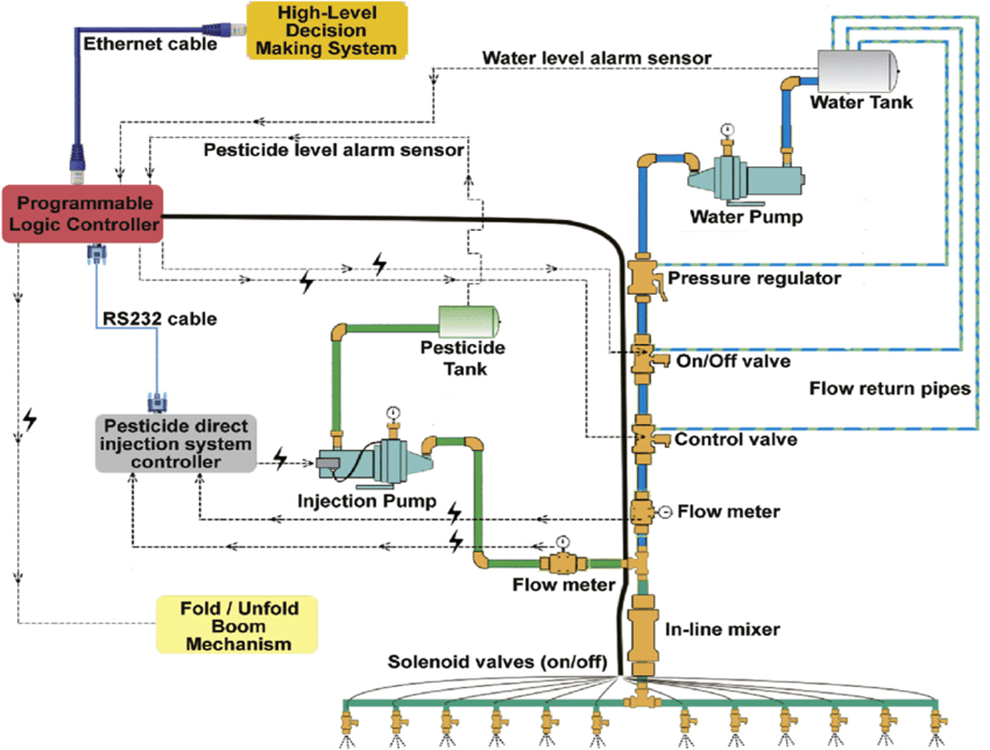
How sensor technology can be use in precision agriculture for efficient pesticides management
Sensor technology plays a crucial role in agriculture precision and efficient pesticides management. By integrating various sensors into agricultural systems, farmers can gather real-time data on soil conditions, weather patterns, crop growth, and pest infestations. This data enables them to make informed decisions about pesticide usage and optimize their application, leading to enhanced efficiency and reduced environmental impact.
Soil moisture sensors, for example, can measure the moisture content in the soil and provide information on irrigation needs. By accurately monitoring soil moisture levels, farmers can avoid over-watering or under-watering, which can lead to water wastage and crop damage. This technology helps optimize pesticide application by preventing excessive runoff due to excessive irrigation or heavy rainfall, which can minimize the risk of water pollution and pesticide drift.
Another important application of sensor technology is the use of weather sensors to monitor environmental conditions. By collecting data on temperature, humidity, wind speed, and rainfall, farmers can anticipate pest outbreaks and make timely decisions on pesticide application. For instance, sensors can alert farmers when specific temperature thresholds are reached, indicating the optimal conditions for certain pests to thrive. By proactively applying pesticides at the right time and targeting specific areas, farmers can minimize the overall pesticide usage.
Furthermore, sensors can also be utilized for pest detection and monitoring. For example, automated pest monitoring systems can incorporate image sensors or acoustic sensors to identify and track pests in real-time. By early detection of pest presence, farmers can deploy targeted pest control methods, such as deploying beneficial insects or using pheromone-based traps, rather than resorting to broad-spectrum pesticides. This targeted approach reduces overall pesticide usage, saves costs, and minimizes the impact on non-target organisms.

How Drones Can Be Use in Agriculture Precision for Efficient Pesticides Management
Drones have proven to be a valuable tool in agriculture precision for efficient pesticides management. Here's how they can be utilized:
1. Mapping and Imaging: Drones equipped with high-resolution imaging devices can capture detailed aerial imagery of crop fields. This allows farmers to detect areas of pest infestation, weed growth, or disease outbreak. By analyzing these images, farmers can accurately identify problem areas that require targeted pesticide application.
2. Remote Sensing: Drones can be equipped with sensors that can collect important data from crop fields, such as temperature, humidity, and plant health indicators. This data can be used to monitor crop conditions and identify areas prone to pest attacks. By understanding the spatial distribution of pest pressure, farmers can optimize their pesticide management strategies and minimize unnecessary pesticide use.
3. Precision Spraying: Drones equipped with pesticide spraying systems can precisely apply pesticides to specific areas of a field, thus minimizing the amount of chemicals used. With the help of GPS technology and mapping data, drones can autonomously navigate the fields and accurately target only the affected areas. This not only reduces environmental impact but also improves cost-effectiveness by reducing pesticide wastage.
4. Monitoring and Timely Intervention: Drones can provide real-time monitoring of crop fields, allowing farmers to quickly identify any changes or developments that require immediate attention. For instance, if a sudden pest outbreak is detected, farmers can swiftly respond by deploying drones for targeted pesticide application, preventing further damage to the crops.
5. Data Analysis and Planning:
The data collected by drones can be analyzed using advanced algorithms and machine learning techniques. This data analysis can provide meaningful insights into pest patterns, crop health, and pesticide efficiency. Farmers can use these insights to optimize pesticide management plans, adjust application rates, and improve overall pest control strategies.

How Internet of Things Can Be Use in Agriculture Precision for Efficient Pesticides Management
The Internet of Things (IoT) can indeed be used in agriculture precision for efficient pesticides management. By integrating IoT devices, sensors, and data analytics, farmers can obtain real-time insights and make informed decisions regarding pesticide use. Here's how it can be achieved:
1. Smart Sensors: IoT-enabled smart sensors can be deployed in fields to continuously monitor key environmental factors such as temperature, humidity, soil moisture, and plant health. These sensors collect data, which is crucial for determining when and where pesticides need to be applied.
2. Data Analytics: The collected sensor data can be analyzed using advanced analytics techniques, such as machine learning algorithms. By analyzing historical and real-time data, farmers can identify patterns, predict disease outbreaks, and determine optimal pesticide usage based on specific crop requirements.
3. Precision Application: IoT can facilitate precise pesticide application by integrating sensor data with automated machinery or drones. This enables targeted spraying, reducing unnecessary pesticide use and minimizing environmental impact.
4. Remote Monitoring: With IoT, farmers can remotely monitor their fields and equipment through connected devices like smartphones or tablets. They can receive alerts and notifications in case of any irregularities, such as sudden temperature changes or signs of pest infestation, enabling timely intervention.
5. Data-driven Decision Making:
By harnessing IoT data, farmers can make data-driven decisions regarding pesticide management. They can optimize pesticide schedules, dosage, and application methods based on the real-time needs of their crops. This ultimately reduces costs, saves resources, and minimizes the negative impacts of excessive pesticide use

How data analytics and decision support systems can be use in agriculture precision for efficient pesticides management.
Data analytics and decision support systems play a crucial role in optimizing the use of pesticides in agricultural precision. By leveraging data from various sources, such as weather patterns, crop health monitoring, pest populations, and historical pest management strategies, these systems can provide valuable insights for efficient pesticides management.
Firstly, data analytics can help in the collection and analysis of extensive datasets related to crop health and pest populations. By considering variables like temperature, humidity, rainfall, and the occurrence of pests, farmers can identify patterns and make informed decisions regarding pesticide application. Analyzing historical data on pest outbreaks and crop responses can also aid in predicting future pest infestations and determining the appropriate timing for pesticide application.
Furthermore, decision support systems can use the analyzed data to generate recommendations for effective pesticides management. These systems can integrate algorithms that take into account factors like crop type, growth stage, pest species, and pesticide characteristics to suggest optimal dosage and application methods. By providing real-time notifications and alerts, these systems help farmers to take timely action that prevent or control pest damage.
Moreover, data analytics and decision support systems enable farmers to monitor the effectiveness of their pesticide management strategies. By continuously collecting data on pest populations, crop health, and pesticide applications, farmers can evaluate the outcomes and adjust their approaches accordingly. This iterative feedback loop enables continuous improvement and overall efficiency in pesticides management.

How Mobile Applications Can Be Use In Agriculture Precision For Efficient Pesticides Management
Mobile applications can greatly enhance precision in pesticide management in agriculture. Here's how they can be utilized:
1. Data Collection: Mobile apps can streamline the collection of crucial data related to pesticide application. Farmers or field technicians can input information such as location, crop type, and pest type, stage of growth, weather conditions, and pesticide used. This data facilitates accurate monitoring and analysis.
2. Pest Identification: Mobile apps can include image recognition algorithms to help users identify various pests and diseases that may affect crops. By promptly identifying the specific pest, farmers can choose the appropriate pesticide and optimize treatment.
3. Dosage Calculation: Mobile apps can assist in calculating the precise amount of pesticide required for a given area or crop. By inputting the details, such as the size of the field or the number of plants, farmers can avoid under or over-application, minimizing both waste and crop damage.
4. Weather Monitoring: Mobile apps can integrate live weather data to provide real-time information on temperature, humidity, rain, wind, and other environmental factors. This information is essential for determining optimal conditions for pesticide application and avoiding adverse effects on crops or the environment.
5. Remote Monitoring: Mobile apps can enable farmers to remotely monitor their fields and pesticide application processes. By connecting to sensors and IoT devices, they can access real-time data on soil moisture levels, pest activity, or even automated pesticide spraying systems. This allows for timely interventions and improved efficiency.
6. Data Analysis and Recommendations: Mobile apps can analyze collected data and provide valuable insights. Utilizing machine learning algorithms, these apps can identify patterns, predict pest outbreaks, and recommend optimized pesticide management practices tailored to specific crops and geographical regions.
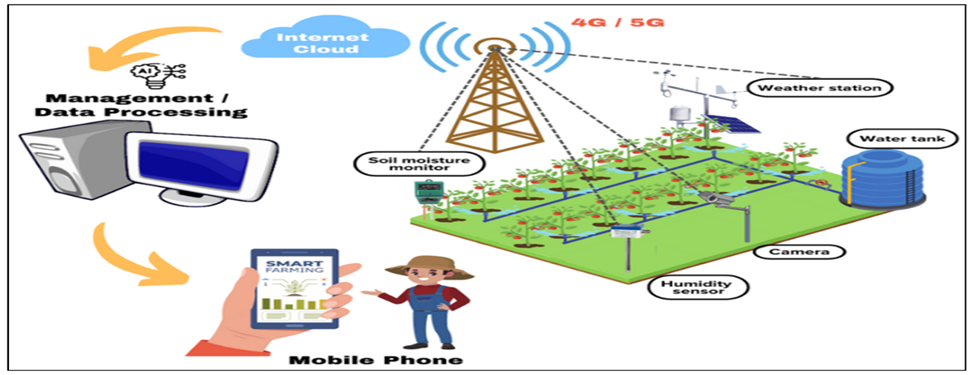
Conclusions and Recommendations
Firstly, the integration of ICT tools in precision agriculture has the potential to revolutionize pesticide management practices. By combining sensor technologies, data analytics, and digital platforms, farmers can make real-time decisions about pesticide application, leading to more efficient and targeted usage. This can help reduce the environmental impact of pesticides while ensuring effective pest control.
Secondly, ICT tools enable farmers to collect and analyze a vast amount of data, allowing them to monitor pest populations, track pesticide usage, and optimize spraying schedules. This data-driven approach ensures that pesticides are applied when and where they are most needed, minimizing unnecessary use and potential crop damage. Additionally, remote sensing technologies, such as drones and satellites, can provide valuable insights on pest distribution and crop health, further improving pesticide management.
Furthermore, the use of ICT tools in precision agriculture can enhance communication and collaboration among stakeholders involved in pesticide management. Real-time data sharing between farmers, agronomists, and agricultural extension services can facilitate timely decision-making and the implementation of integrated pest management strategies. This collaborative approach can lead to more sustainable and effective pesticide management practices.
However, it is important to acknowledge that the successful implementation of ICT tools in precision agriculture requires overcoming certain challenges. Issues related to data privacy and cyber-security need to be addressed to ensure the protection of sensitive agricultural data. Furthermore, accessibility to these technologies, particularly in rural areas, may present barriers that need to be overcome to ensure equitable adoption.
In conclusion, the research findings indicate that the use of ICT tools in precision agriculture holds great potential for improving pesticide management practices. By leveraging data analytics, sensor technologies, and digital platforms, farmers can optimize pesticide usage, reduce environmental impact, and enhance overall crop productivity. The integration of ICT tools also promotes collaboration and knowledge-sharing among stakeholders, leading to more sustainable and efficient pesticide management strategies. However, addressing challenges related to data privacy and technology accessibility is crucial for successful implementation. Overall, the findings suggest that embracing ICT tools in precision agriculture can contribute to a more sustainable and efficient agricultural system.
Recommendations
- Define clear research objectives: Clearly define the purpose and goals of your research on evaluating the use of ICT tools in precision agriculture for efficient pesticide management.
- Select appropriate ICT tools: Identify and evaluate a range of ICT tools that are applicable to precision agriculture and pesticide management.
- Conduct field studies: Perform field studies in real-world agricultural settings to assess the effectiveness of the selected ICT tools in pesticide management.
- Collect and analyze data: Gather comprehensive data on pesticide application rates, crop health, yield, and economic factors both with and without the use of ICT tools.
- Consider socioeconomic factors: Evaluate the socioeconomic implications of implementing ICT tools in precision agriculture for pesticide management.
- Assess environmental impact: Investigate the potential environmental benefits of adopting ICT tools in pesticide management practices.
- Engage stakeholders: Collaborate with farmers, agricultural organizations, technology providers, and researchers to gain insights and ensure that the research is aligned with industry needs.
- Long-term monitoring: Consider the long-term effects of using ICT tools in precision agriculture.
- Promote knowledge sharing: Publish research findings in scientific journals, present them at conferences, and engage with relevant communities to share knowledge and encourage further research and adoption of ICT tools in precision agriculture.
- Provide policy recommendations: Based on the research outcomes, offer policy recommendations to government agencies and agricultural authorities regarding the integration of ICT tools in precision agriculture.
References
- SRINIVASAN, A. (2006). Site-Specific Nutrient Management: Objectives, Current Status, and Future Research Needs. In Handbook of Precision Agriculture (pp. 121-182). CRC Press.
- McBratney, A., Whelan, B., Ancev, T., & Bouma, J. (2005). Future directions of precision agriculture. Precision agriculture, 6, 7-23.
- Whelan, B. M., & McBratney, A. B. (2003, February). Definition and interpretation of potential management zones in Australia. In Proceedings of the 11th Australian Agronomy Conference, Geelong, Victoria (pp. 2-6).
- Kaspar, T. C., Colvin, T. S., Jaynes, D. B., Karlen, D. L., James, D. E., Meek, D. W., ... & Butler, H. (2003). Relationship between six years of corn yields and terrain attributes. Precision agriculture, 4, 87-101.
- McBratney, A. Á., & Pringle, M. J. (1999). Estimating average and proportional variograms of soil properties and their potential use in precision agriculture. Precision Agriculture, 1, 125-152.
- Marios, S., & Georgiou, J. (2017, October). Precision agriculture: Challenges in sensors and electronics for real-time soil and plant monitoring. In 2017 IEEE Biomedical Circuits and Systems Conference (BioCAS) (pp. 1-4). IEEE.
- Sophocleous, M. (2016). "IoT & Thick-Film Technology for Underground Sensors in Agriculture".


